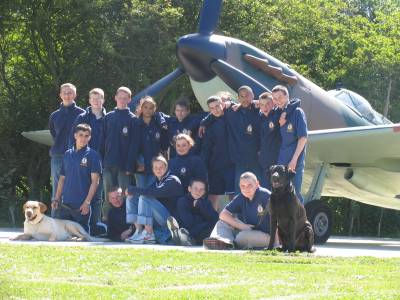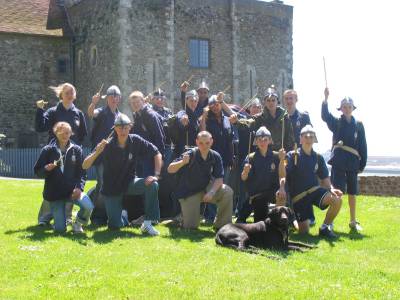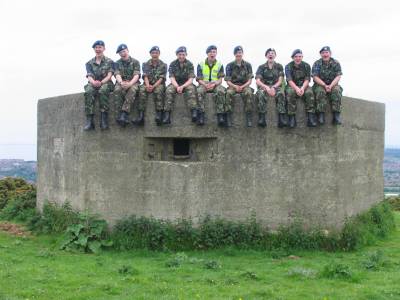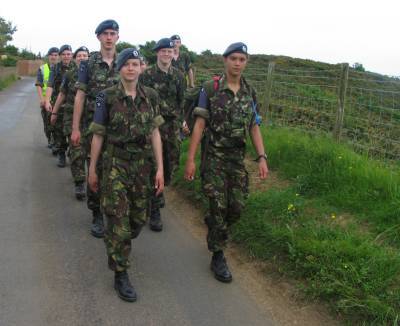|
134 (Bedford) Sqn Air Cadets |

|
| < 21st May 2005 - Open Day 2005 | 20th June 2005 - Water Wings > |
Press Release |
134 (Bedford) Squadron |
1st June 2005
Best Foot Forward
The 2005 Folkestone Cadet March saw a deployment of 16 cadets and 6 staff from 134 (Bedford) Squadron to the annual road walking event which is held over the second Bank Holiday weekend in May

Route marching has been a popular event within the armed forces and cadet movement for many years with famous events such as Nijemegan in Holland, and although not as long the, Folkestone Cadet March which is also known as the Spitfire March still offers as sense of achievement. 134 (Bedford) Squadron has now completed two successful deployments to the Spitfire March in recent times and is now regarded as an annual activity on the squadron calendar. Offering three different routes, the event caters for all abilities of walkers starting with the 12 mile yellow route through to the blue route at 16 miles and finally a red route of 25 miles for those wishing to tackle a real challenge. However the Folkestone area has much more to offer than just a walk in the countryside and for that reason a Bedford Sqn offers a long weekend camp with the march as the central focus.

Situated on the Kent coast and overlooking the English Channel the local area is rich in military history dating back to the Roman period and running up to the end of the Cold War. Setting off from Bedford on Friday evening the majority of the cadets arrived at Dibgate Camp on St Martins Plain Army Training Area to find the advanced party well on the way with setting up camp before settling in for the night. Following reveille and breakfast on Saturday the squadron travelled to Dover Castle for a tour around the secret wartime tunnels within the cliffs and a chance to learn more about the military significance of this strong point. During the visit the cadets were shown the remains of a dummy 'upkeep' mine which was used by 617 Sqn for the Dambusters raid, this tied in with another recent learning event held by 134 (Bedford) Sqn. The mine had been recovered from the seabed some years ago having been left over from practise sorties conducted during 1943 off of the Kent coast shortly before the raid.
Saturday afternoon was spent visiting the Battle of Britain Memorial at Capel-Le-Ferne, which is situated on the cliff tops between Dover and Folkestone at the site of a world war two anti aircraft gun emplacements. The permanent memorial is a poignant reminder to the fighter pilots of the RAF who became known as 'the few', it features a stone sculpture of a pilot sitting on a plinth which bears the crests of the squadrons that fought in the summer of 1940. The sculpture and plinth sit in the centre of the memorial which when viewed from the air resembles a giant three bladed propeller marked out in paving. Also at the site are full size replicas of a Spitfire and a Hurricane as well as other points of remembrance.

Sunday, the day of the cadet march started out very warm, the squadron had been divided into two teams, the blue team included cadets who were tackling route marching for the first time while the red team consisted of those feeling a little more energetic with the goal of completing the 25 mile route. Setting off first the reds were followed a short time later by the blue team. All three routes start and finish on the same sections of road but split at various points. With both teams in high spirits good progress was reported, the routes headed inland from Dibgate passing around the back of the Eurotunnel terminal and uphill towards the WW2 airfield at Hawkinge. Shortly afterwards the red and blue routes divide with the reds heading yet further inland. Taking in views of the garden of England the teams sang and chanted their way around the network of country lanes. While the blues set course for Caple-Le-Ferne the reds were dealing with their additional 9 miles before rejoined the blue route. At Caple-Le-Ferne blue team returned to the memorial that the squadron had visited the day before for a break where the Red Arrows treated them to a chance flypast. From here the two courses head along the ridge above Folkestone, which afforded some good views across the channel and down the coast to the nuclear power station at Dungeness. On top of the ridge the blue team found some pillboxes dating back to the WW2 and a Royal Observer Corps observation bunker from the Cold War, here AWO Taylor gave an impromptu history lesson explaining the role that ROC played during those dark times. One final checkpoint and a cup of tea gave the teams hope of completing the course which involved descending the hill, passing back past the Eurotunnel terminal and onto the same road that the course had started out on. With one final drive the teams sang their way up the final hill and onto Dibgate camp for the finish. The remainder of Sunday afternoon and evening was spent tending to sore feet, aching muscles and the odd blister at which point Commanding Officer Flt Lt Whittaker's Nijemagen experience proved very useful. After a fantastic evening meal, which was prepared by Mrs Croft of the Civilian Committee, everyone sat down to an evening in the cinema tent to watch the film 633 Sqn.

Bank Holiday Monday was taken fairly easily with everyone up at 0700hrs with his or her personal kit packed, tents stripped and ready for breakfast at 0900hrs, and as soon as everyone had eaten the squadron pulled together as a team to get the lorry and two minibuses loaded for a 1200hrs departure. Arriving back at 134 Sqn HQ the cadets and staff fought their tiredness to unload the vehicles, check and clean the equipment and return it all to stores ready for the next adventure.